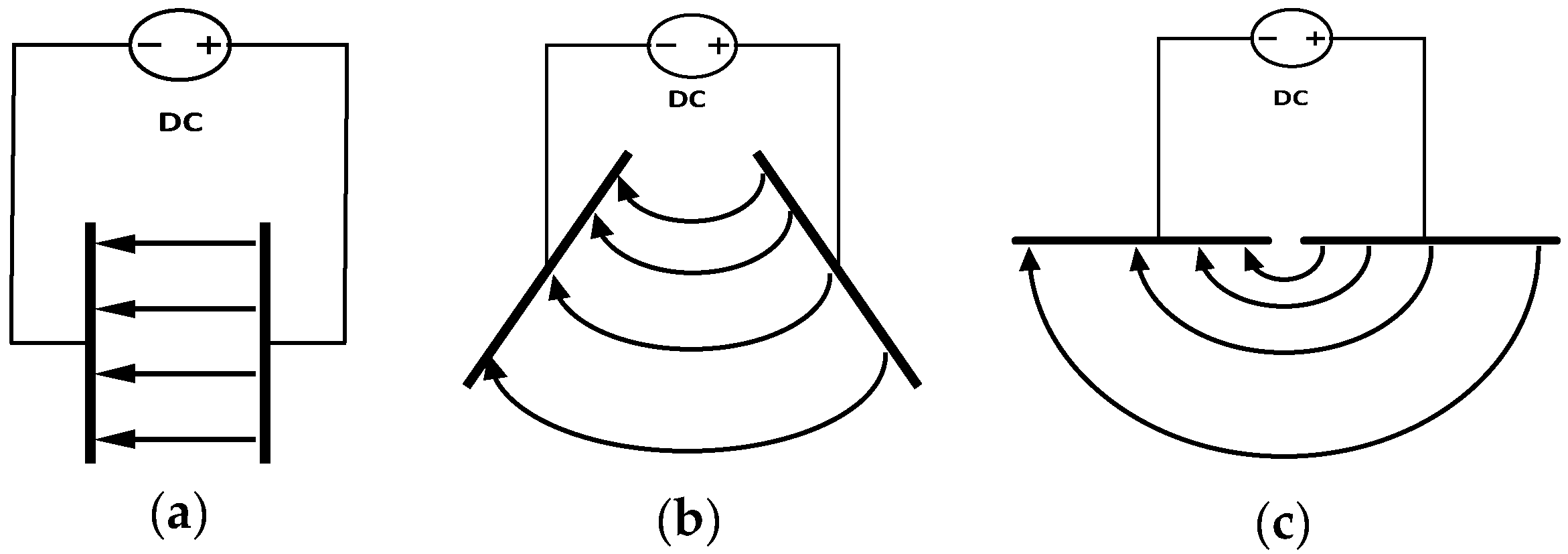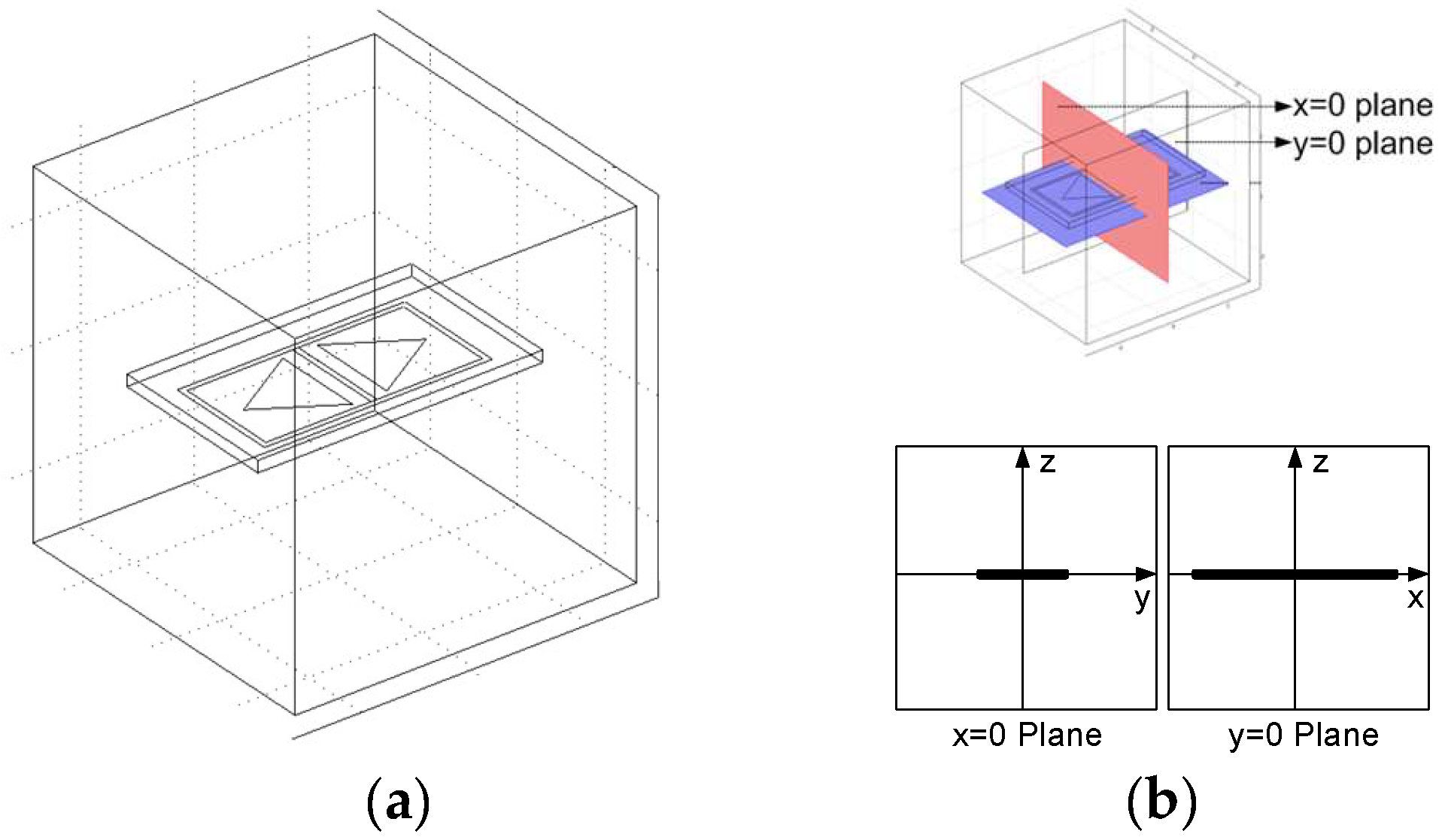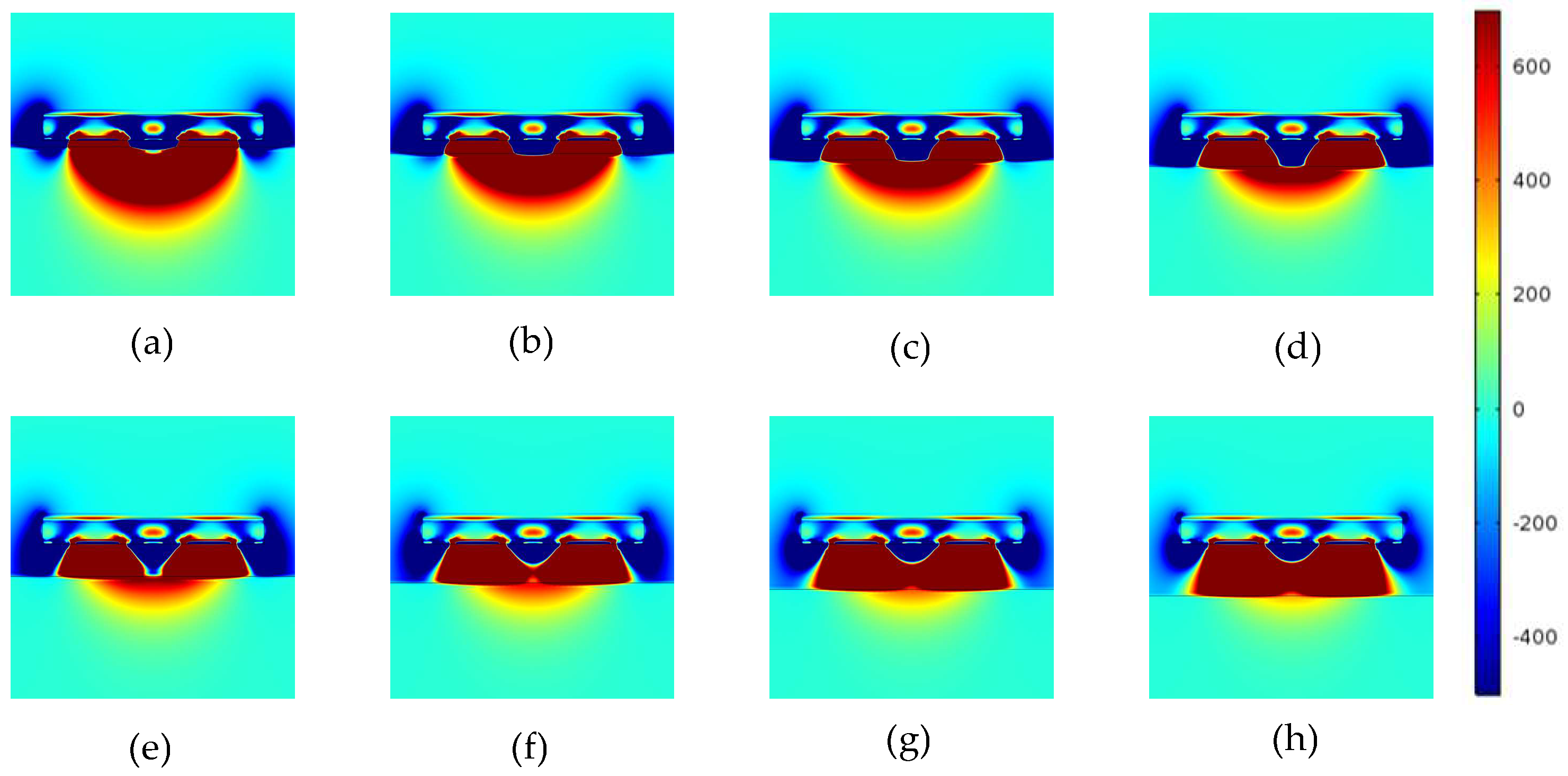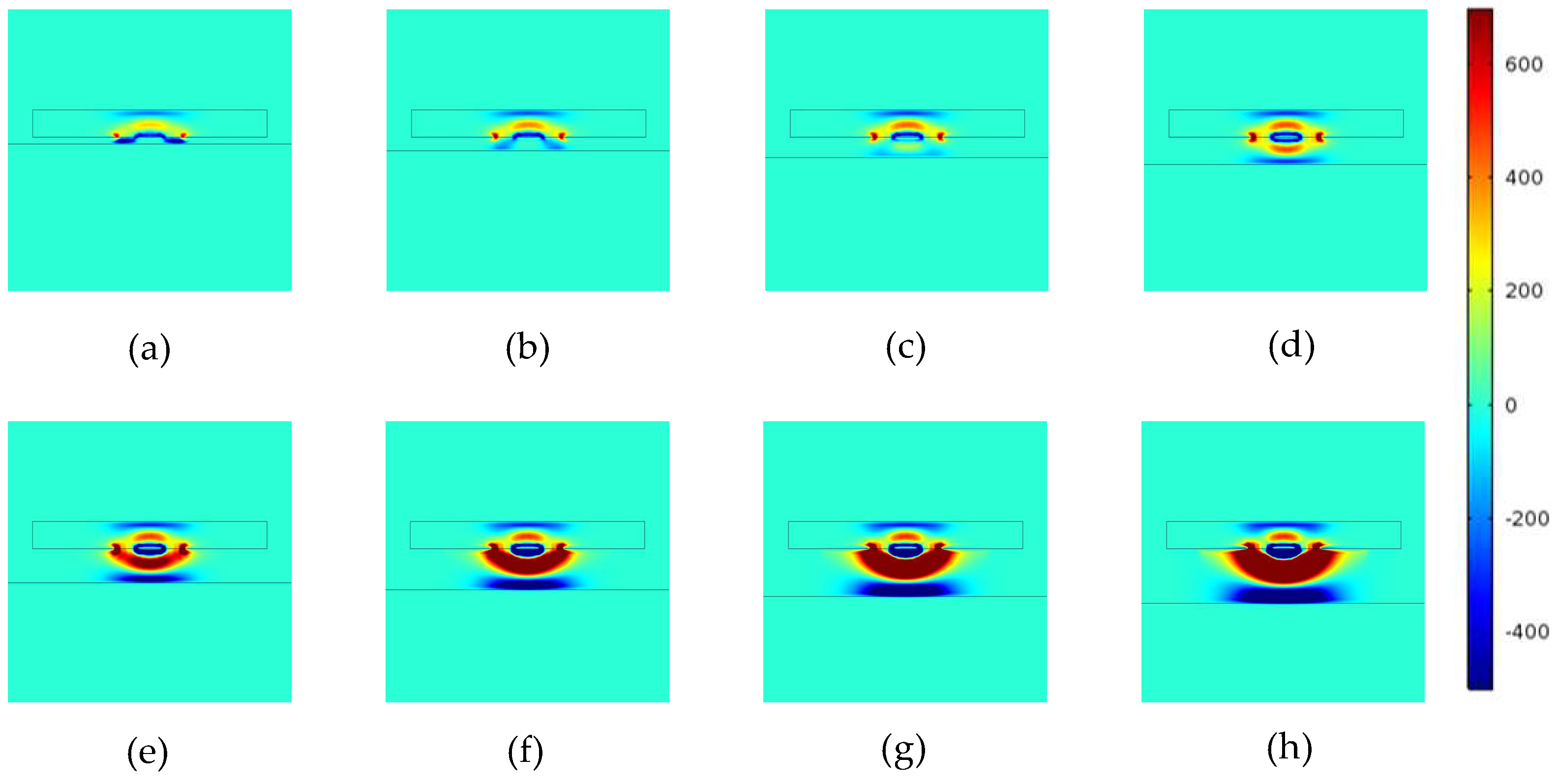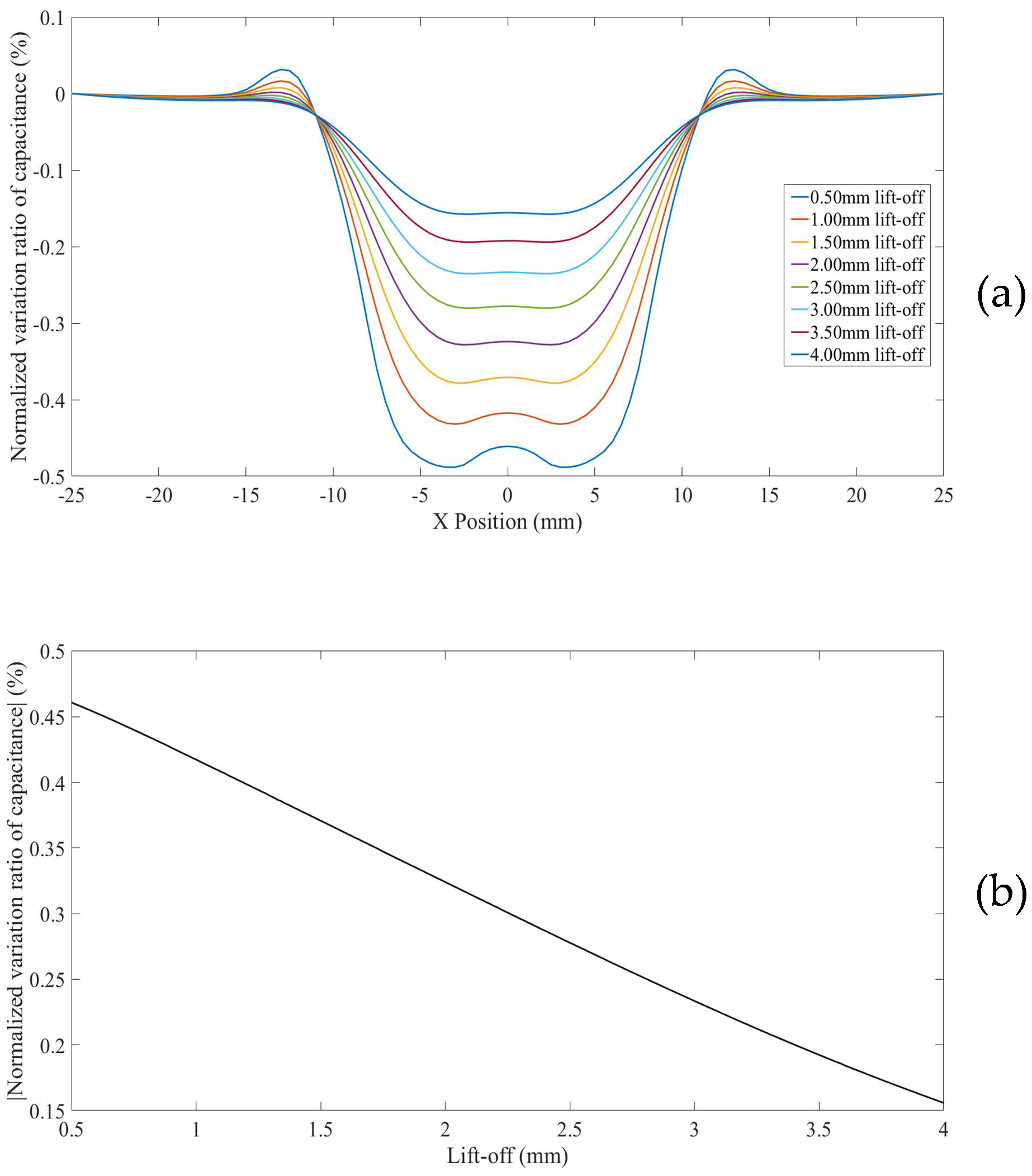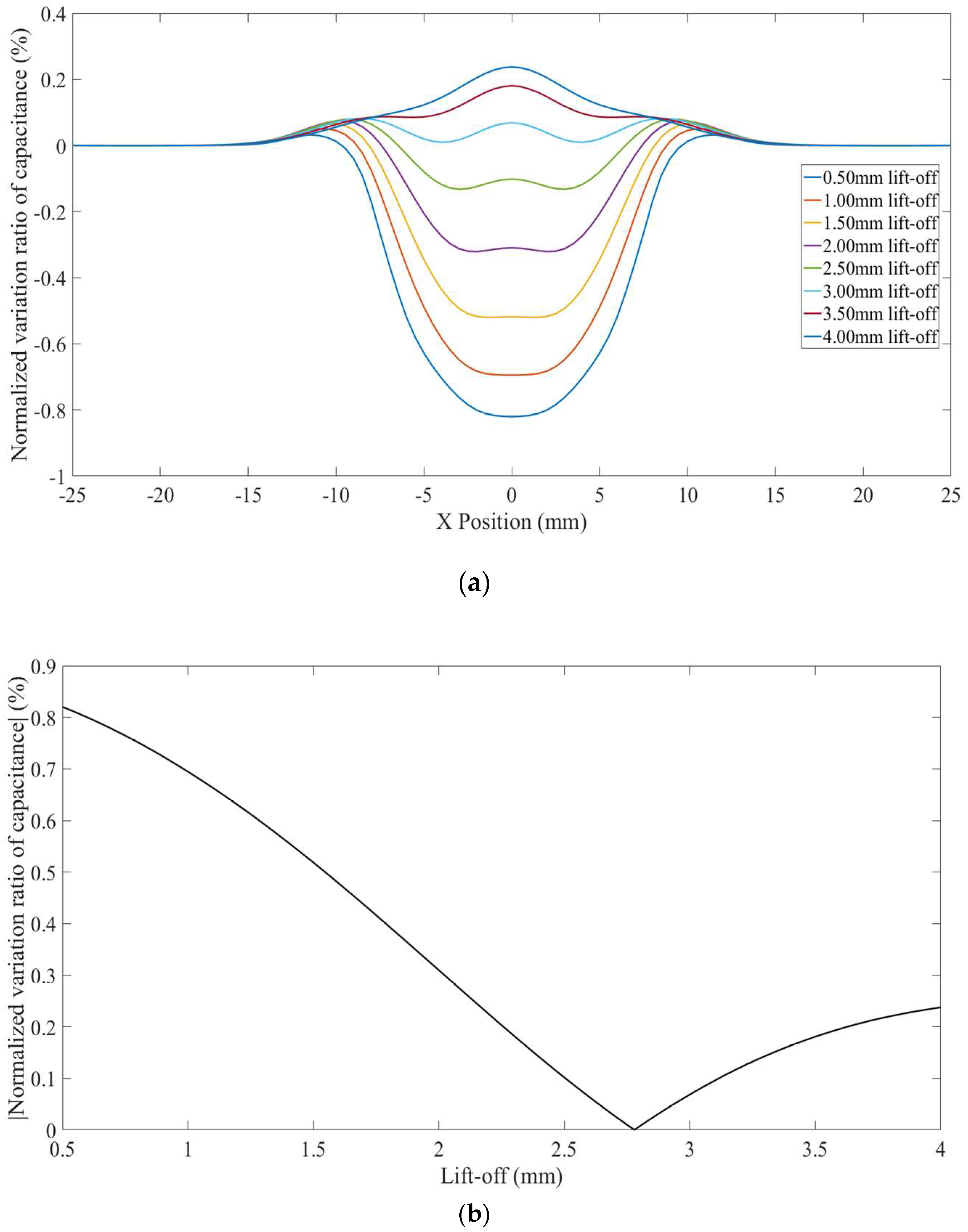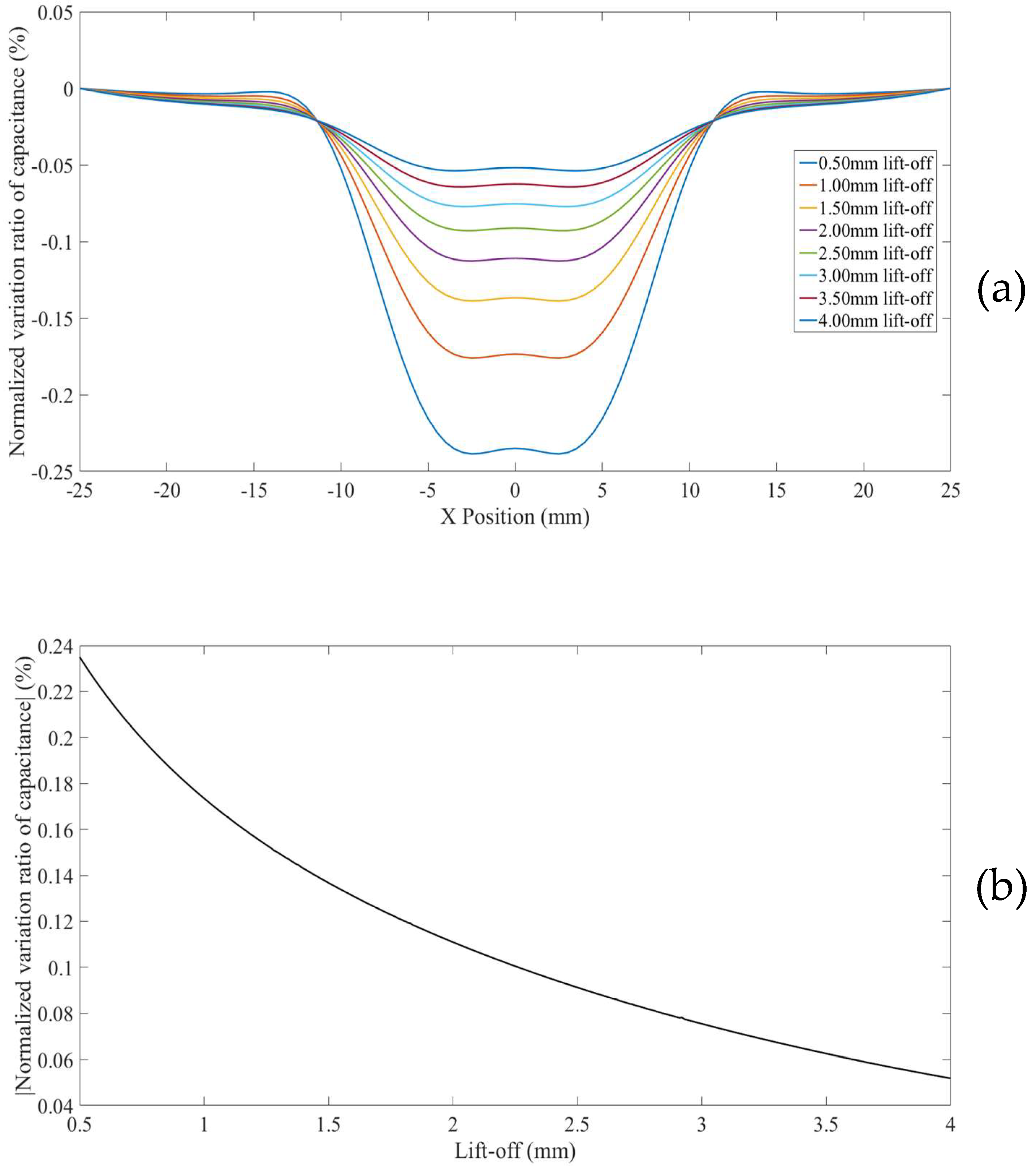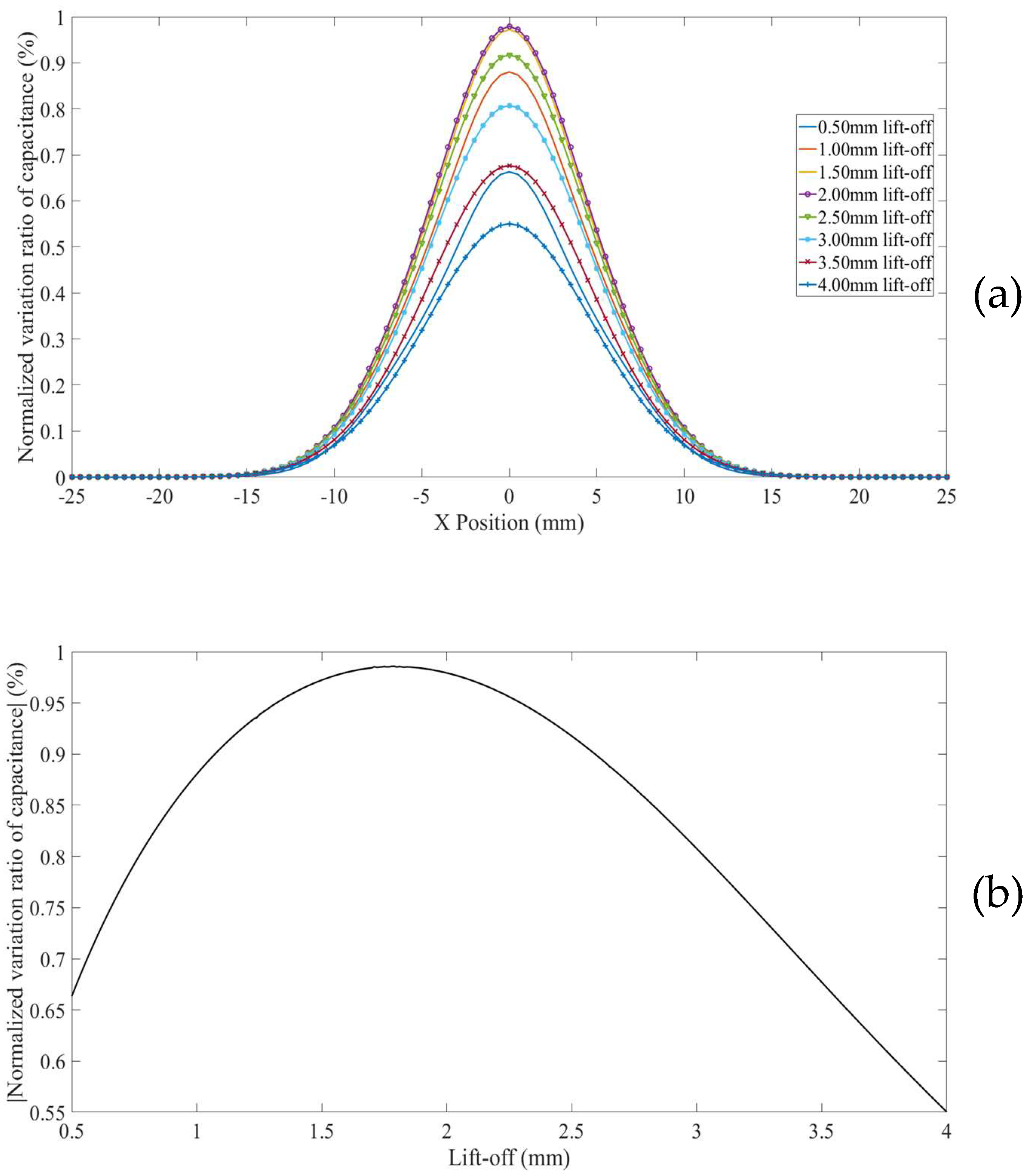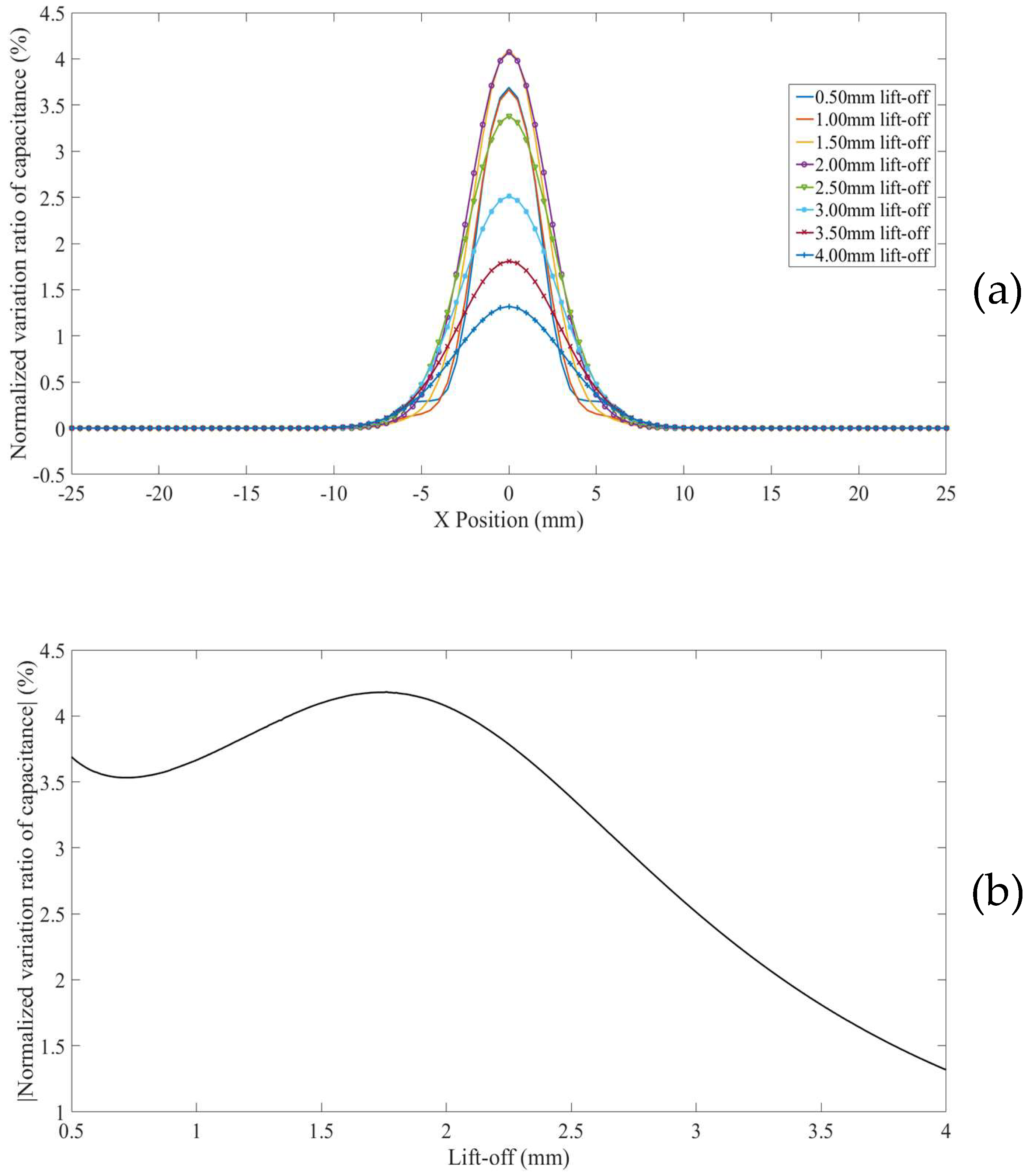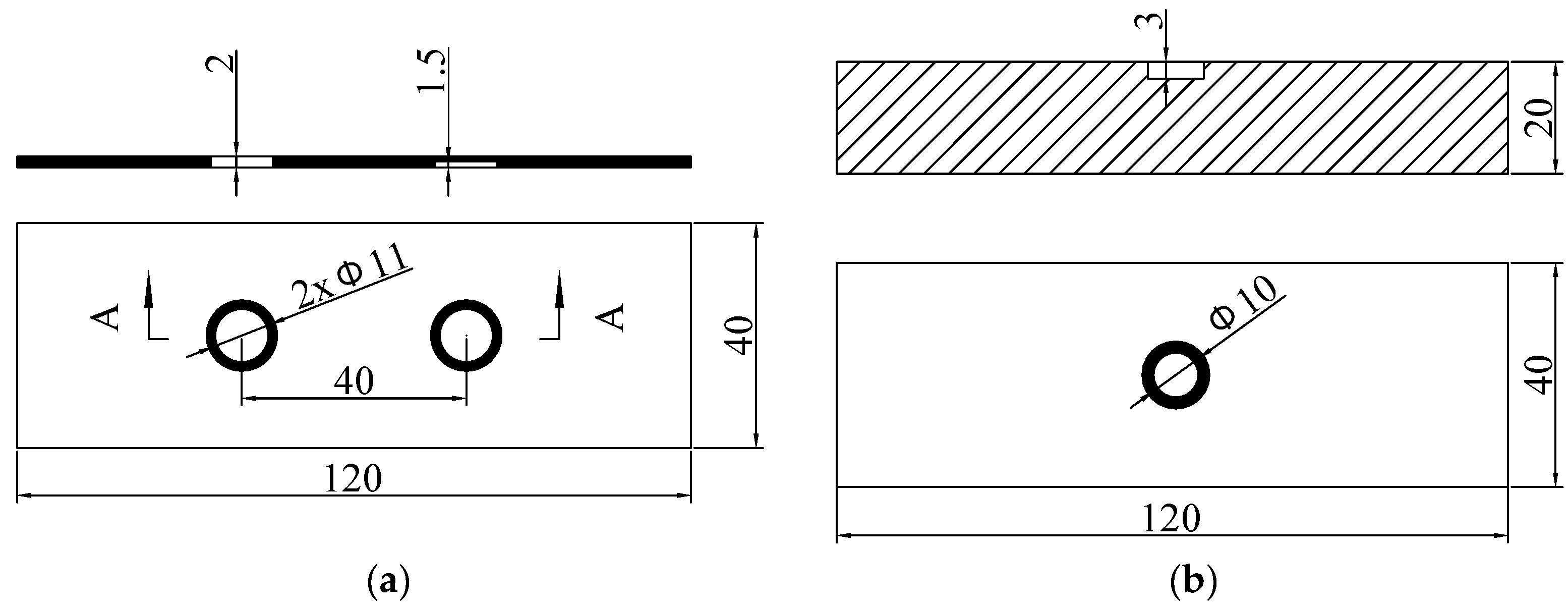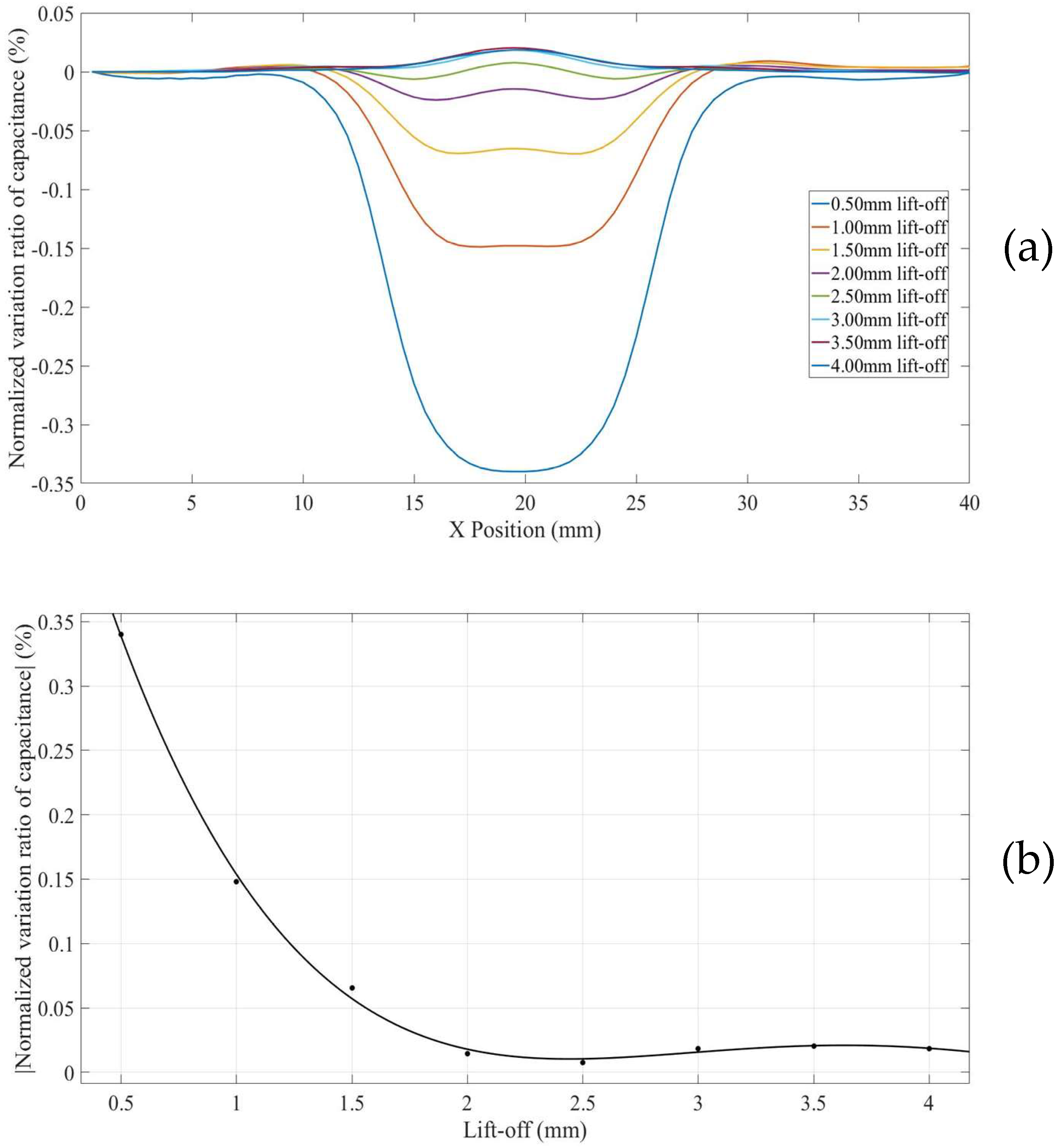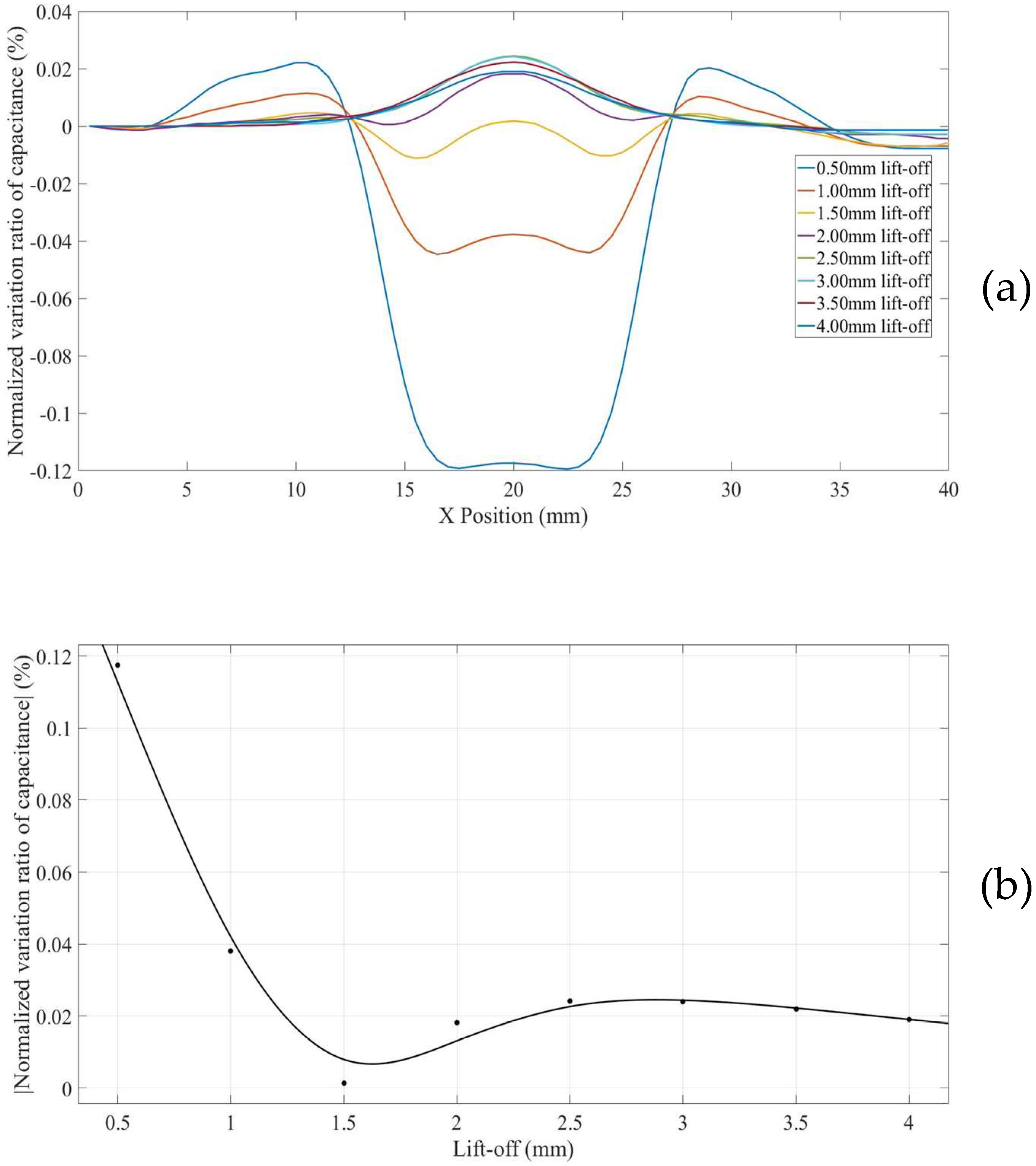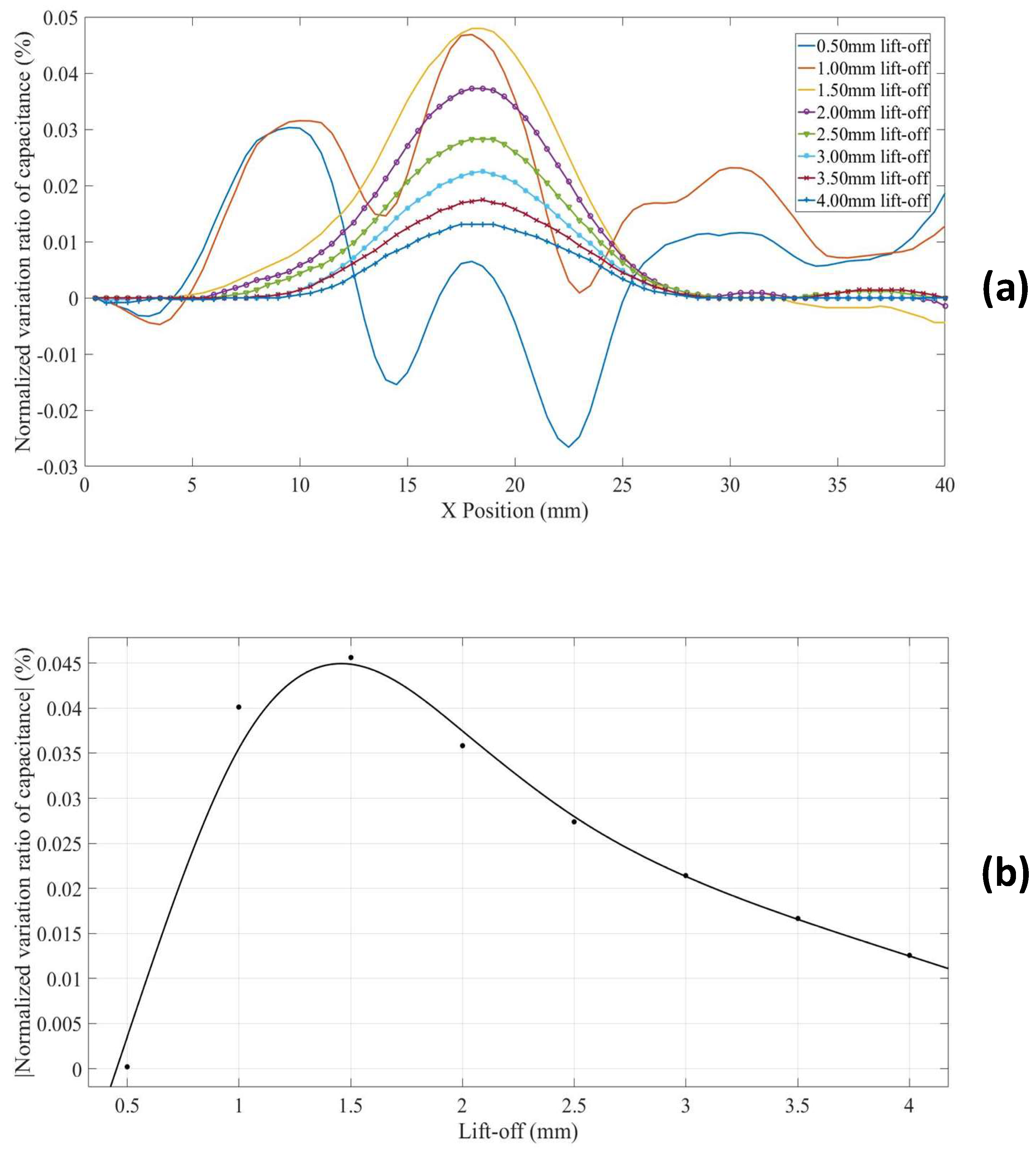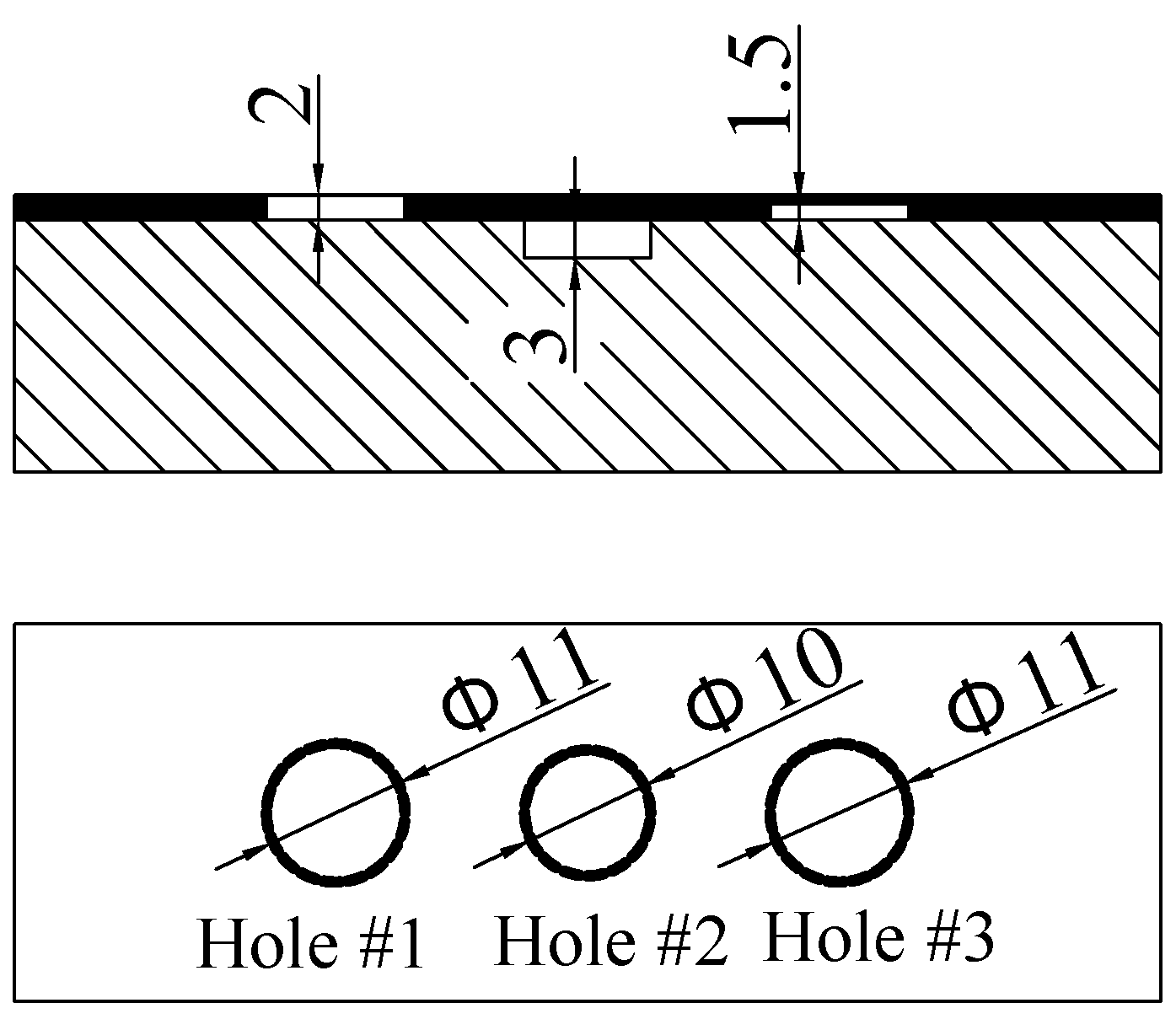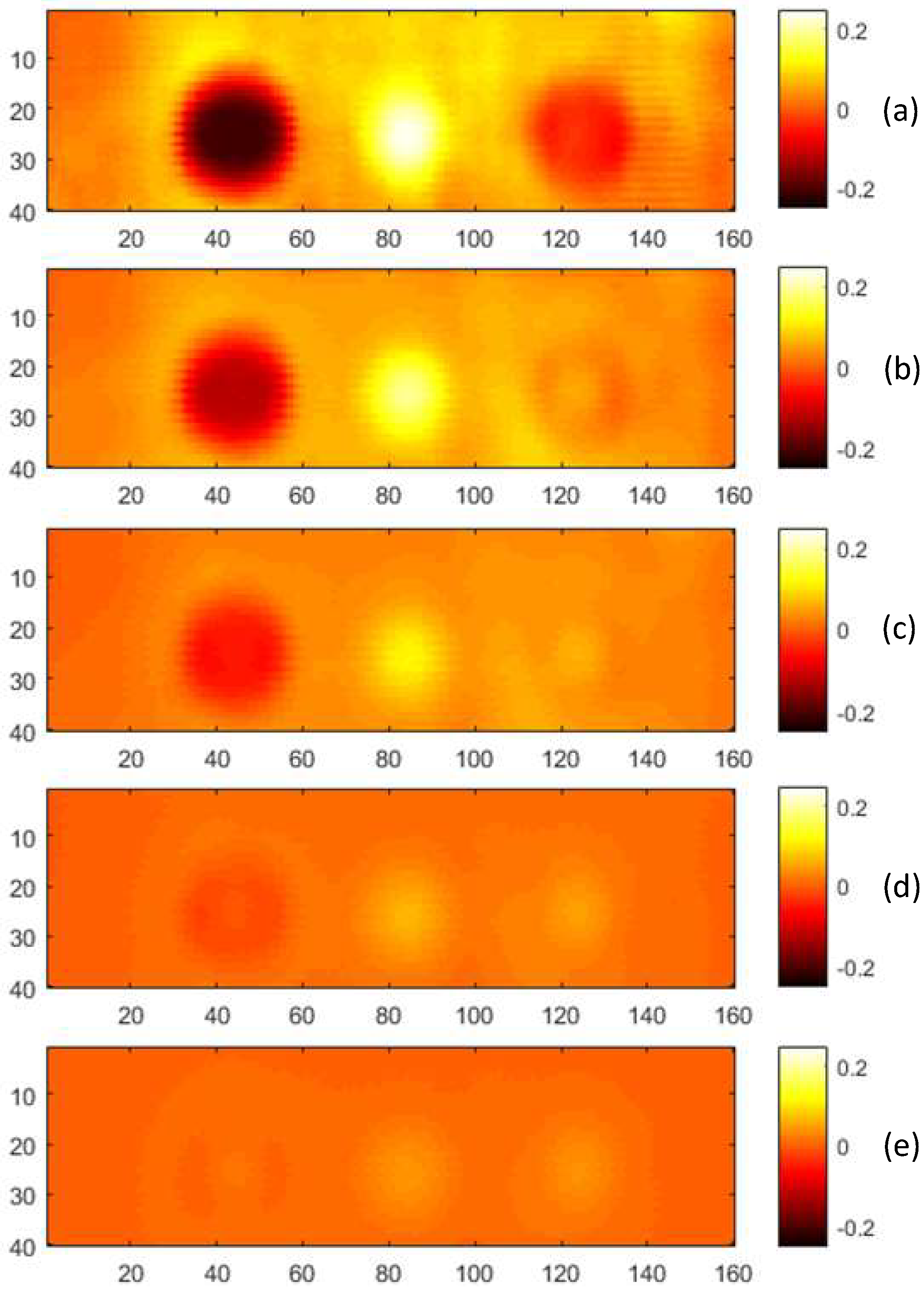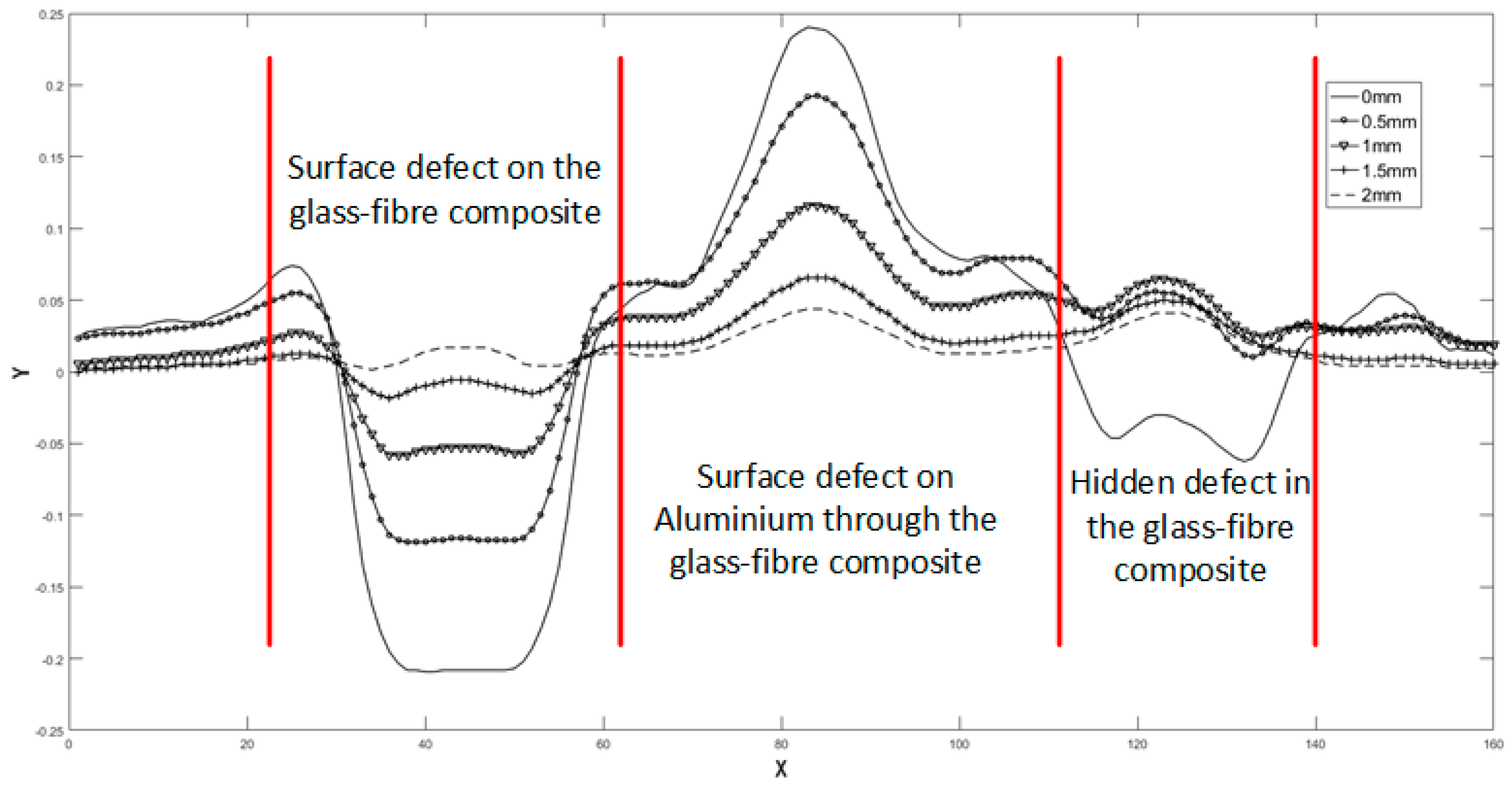1. Introduction
Non-destructive evaluation (NDE) techniques have been widely used in various applications, i.e., crack detection, material degradation evaluation, weld joint diagnosis, etc., to ensure system safety and reliability [
1,
2]. In recent years, many novel NDE techniques have been investigated to target the ever growing inspection challenges. The Capacitive Imaging (CI) technique, which uses the fringing quasi-static electric field from coplanar electrodes, has emerged as a promising technique for the NDE of glass-fibre composites [
3], composite insulators [
4], concrete [
5], and Corrosion Under Insulation (CUI) [
6]. Similar to the eddy current [
7,
8,
9] and many other electromagnetic NDE methods [
10], the CI technique is also sensitive to sensor lift-off. Due to the non-linearity of the probing electric field, the measurement sensitivity value of a coplanar CI sensor in each position in the sensing area is heavily position dependent. Previous work indicated that the measurement sensitivity at different positions under a given CI sensor can vary from positive, through zero to negative [
11]. It is also found that the measurement sensitivity distribution can be greatly affected by sensor lift-off, leading to very different imaging results. The complex capacitance changes due to lift-off variations, referred to as the lift-off effect, is previously known to be one of the main obstacles for effective CI NDE as it can easily mask defects. Previous knowledge suggested that the measurements using coplanar capacitive sensors should always be taken at a minimal lift-off/in contact with the specimen, as it is believed that increased lift-offs will greatly and monotonically reduce measurement sensitivity. However, thanks to the high precision measurement circuits now available, the latest practical CI measurements do not always agree with this argument.
Extensive efforts, including sensor design and optimization, advanced signal processing techniques, and new inversion methods, have been presented into the reduction of the lift-off effect in the eddy current and related techniques, as it significantly reduces the effectiveness of defect inspection. Fu presented a new approach based on the dynamic trajectories of the fast Fourier transform (FFT) of the received signals for reducing the lift-off effect [
12]. Y. He found that differential process can eliminate the lift-off in PEC defect classification in both time the domain and frequency domain [
13]. Fan presented a model-based inversion method in terms of lift-off reduction for eddy current characterization of a plate [
14] and investigated the behaviors of LOI due to a plate with varying conductivity and thickness in PEC response for elimination of lift-off effect [
15]. Ribeiro used the theory of the linear transformer to explain the lift-off effect with special attention to the point of interception phenomenon and presented an apparatus capable of measurement of the thickness of a metallic non-ferromagnetic plate [
16]. For capacitive sensors, up to now, little attention has been paid to the lift-off effect in the CI technique. Studies on the lift-off effect [
17] and their reduction methods for capacitive sensors, mainly with novel sensor designs [
18,
19], can only be found sporadically in the literature. It is thus important to carry out a systematic investigation of the lift-off effect and to propose an efficient way to use information arising from varying lift-offs for defect characterisation.
In this work, the concept of the Measurement Sensitivity Distribution (MSD) was introduced and the lift-off effect on the MSD for different types of specimens is discussed in
Section 2. This is then followed by analysis on Finite Element (FE) models. The lift-off effect for surface/hidden defects in non-conducting specimens and defects on conducting surfaces through insulation were studied using FE models in
Section 3. CI experiments with different lift-offs were also carried out on a glass-fibre composite specimen, and an aluminium specimen. Both surface and hidden artificial defects (machined flat-bottom holes with different depths) were utilized to simulate the commonly seen defect types in practical applications. The experimental results are presented and discussed in
Section 4. Discussion and conclusions are then presented in
Section 5.
4. Lift-Off Experiments
Experiments were designed and carried out to study the lift-off effect for the cases discussed in the previous section. The CI sensor shown in
Figure 2 was used in all the experiments in this section. The sensor was part of the basic CI instrumentation. To measure the signal at any particular location, a single frequency AC voltage (10 V pk-pk at 10 kHz) from a signal generator (AFG1022, TektronixTM, OH, USA) was applied as the driving voltage to one of the electrodes in the CI sensor. A LC0601 charge amplifier (Lance
TM, Qinhuangdao, China) was used to convert the charge signal on the sensing electrode to an AC voltage signal, which could then be recorded if desired. A 7230 lock-in amplifier (Signal Recovery
TM, TN, USA) which converts the AC voltage signal into a DC voltage proportional to the amplitude of the received AC signal. The DC output was then recorded by the PXI system (NI
TM, TX, USA). The NI
TM PXI system also controlled an
X-Y-Z scanning stage, which could be used to translate the CI sensor across the sample surface or change the lift-offs. The experimental setup is shown in
Figure 15.
The specimens used in the experiments are a 2 mm thick glass-fibre composite boards and a 20 mm thick aluminium board. The glass-fibre composite boards (Specimen I) is with a machined through hole 11 mm in diameter and a 1.5 mm deep machined flat-bottomed hole also 11mm in diameter, as shown in
Figure 16a. The aluminium board (Specimen II) is with a flat-bottomed hole 10 mm in diameter and 3 mm in depth (shown in
Figure 16b).
The first set of CI line scans were taken across the through hole on Specimen I, with the specimen placed on top of a 50 mm thick Perspex plate, to study the surface defect in the thick non-conductor case, as discussed in
Section 3.1. In this case, the grounded metal plate on the workbench has little influence on the imaging performance. Eight line scans with the lift-off increased from 0.5 mm to 4 mm at a 0.5 mm increment were taken. The
NVRs of capacitance against scan position with the eight lift-offs are plotted in
Figure 17a. For clarity, as in the simulated scans, the absolute values of the
NVRs obtained at the central position of the defect for each lift-off were plotted against lift-offs, as shown in
Figure 17b. It can be seen from
Figure 17a that, the surface defect appeared as a depression at smaller lift-offs (i.e., lift-off less than 2.5 mm), while at a bigger lift-off (i.e., lift-off more than 2.5 mm), the defect appear as a bulge. The absolute values of the NVRs obtained at the central position of the defect varies non-monotonically with increased lift-offs, it decreases at small lift-off, reaches its local minimum value at roughly 2.5 mm lift-off, and increases between 2.5 mm and 3.5 mm and slightly decreases again, as shown in
Figure 17b. The
NVR switched its sign, as at a certain lift-off (i.e., roughly 2.5 mm in this case), at this critical lift-off the CI sensor is insensitive to surface defect.
The second set of CI line scans were also taken across the through hole on Specimen I, with the specimen placed on top of a grounded metal plate, to study the surface defect in a non-conductor with a grounded substrate case, as discussed in
Section 3.2. Eight line scans with the lift-off increased from 0.5 mm to 4 mm at a 0.5 mm increment were taken. The
NVRs of capacitance against scan position with the eight lift-offs are plotted in
Figure 18a. The absolute values of the NVRs obtained at the central position of the defect for each lift-off were plotted against lift-offs, as shown in
Figure 18b. It can be seen from
Figure 18a that, the surface defect appeared as a depression at even smaller lift-offs (i.e., lift-off less than 1.5 mm), while at a bigger lift-off (i.e., lift-off more than 1.5 mm), the defect appear as a bulge. The absolute values of the
NVRs obtained at the central position of the defect varies non-monotonically with increased lift-offs, it decreases at small lift-off, reaches its local minimum value at roughly 1.6 mm lift-off, and increases between 1.6 mm and 3 mm and slightly decreases again, as shown in
Figure 18b. Note that in this case the critical lift-off is roughly 1.6 mm.
The third set of CI line scans were taken across 1.5 mm deep flat-bottomed hole on Specimen I, with the specimen facing down and placed on a 50 mm thick Perspex plate, to study the hidden defect in a thick non-conductor case, as discussed in
Section 3.3. In this case, the grounded metal plate on the workbench has little influence on the imaging performance. Eight line scans with the lift-off increased from 0.5 mm to 4 mm at a 0.5 mm increment were taken. The
NVRs of capacitance against scan position with the eight lift-offs are plotted in
Figure 19a. The absolute values of the
NVRs obtained at the central position of the defect for each lift-off were plotted against lift-offs, as shown in
Figure 19b. It can be seen from
Figure 19a that, the hidden defect appeared as a depression at even smaller lift-offs (i.e., lift-off less than 1.3 mm), while at a bigger lift-off (i.e., lift-off more than 1.3 mm), the defect appear as a. The absolute values of the
NVRs obtained at the central position of the defect varies non-monotonically with increased lift-offs, it decreases at small lift-off, reaches its local minimum value at roughly 1.3 mm lift-off, and increases between 1.3 mm and 3 mm and slightly decreases again, as shown in
Figure 19b. Note that in this case, at a lift-off of 1.3 mm, the CI sensor is insensitive to the hidden defect buried 0.5 mm under the surface.
The fourth set of CI line scans were taken across 1.5 mm deep flat-bottomed hole on Specimen I, with the specimen facing down and placed on grounded metal plate, to study the hidden defect in a non-conductor with a grounded substrate case, as discussed in
Section 3.4.
Eight line scans with the lift-off increased from 0.5 mm to 4 mm at a 0.5 mm increment were taken. The
NVRs of capacitance against scan position with the eight lift-offs are plotted in
Figure 20a. The absolute values of the
NVRs obtained at the central position of the defect for each lift-off were plotted against lift-offs, as shown in
Figure 20b. It can be seen from
Figure 19a that, the hidden defect appeared as a depression at 0.5 mm lift-off, and bulges for bigger lift-offs. The absolute values of the
NVRs obtained at the central position of the defect increase at first and then decreases with increased lift-offs, as shown in
Figure 20b. The difference between
Figure 19b and
Figure 20b suggested that the negative measurement sensitivity value zone of the CI sensor was concentrated in the non-conducting specimen due to the presence of the grounded substrate.
The fifth set of CI line scans were taken across 3 mm flat-bottomed hole on Specimen II, with the specimen grounded, to study the surface defect on a conducting surface, as discussed in
Section 3.5. Eight line scans with the lift-off increased from 0.5 mm to 4 mm at a 0.5 mm increment were taken. The
NVRs of capacitance against scan position with the eight lift-offs are plotted in
Figure 21a. The absolute values of the NVRs obtained at the central position of the defect for each lift-off were plotted against lift-offs, as shown in
Figure 21b. It can be seen from
Figure 21a that, the surface defect appeared as a bulge for all the lift-offs. The absolute values of the NVRs obtained at the central position of the defect varies non-monotonically with increased lift-offs, as shown in
Figure 21b. There exist a local maximum
NVR value at roughly the 1.5 mm lift-off, suggesting that, such lift-off is an optimal lift-off for surface defect inspection.
NVR decreases monotonically with increased lift-offs after the so-called optimal lift-off.
After CI line scans with various lift-offs for different defects/specimens/experimental conditions were carried out, a hybrid structure with multiple defects was tested, as a case study, to demonstrate how the lift-off effect can help to provide extra information. In this case study, the glass-fibre composite board (Specimen I) was placed on top of the aluminium board (Specimen II), in an attempt to find the different variation trends with increased lift-offs for various types of defects in different materials. The surface hole in the aluminium board was placed between the two holes (the through hole and the 1.5mm hole) in the glass-fibre composite board to simulate different defects in the metal with insulation structure, as shown in
Figure 22.
The scans were taken with minimal lift-off, 0.5, 1, 1.5 and 2 mm lift-offs. During the CI scans, the aluminium board was grounded. The measured values were also transformed into the
NVRs, which were used to form capacitive images, as shown in
Figure 23. For direct comparison, the images are plotted in the same colour range.
The central line of each scan was extracted and plotted in a single figure (
Figure 24).It can be seen from
Figure 24 that:
For a minimal lift-off, Hole #1, Hole #3 appeared as depression and Hole 2 appeared as a bulge in the plotted line, while for a 2 mm lift-off, all the three holes appeared as bulges in the plotted line.
For Hole #1, the NVR of central position of the hole increased from negative through zero to positive. For Hole #2, the NVR of central position of the hole was always positive and decreased with increasing lift-off. For Hole #3, different from the first two holes, the obtained NVR lines are crossed (NVR @1 mm > NVR @0.5 mm > NVR @1.5 mm), which indicated that the NVR of central position of the hole increased from negative through zero to a local maximum positive value and then decreased slightly.
In this set of experiments, the scans for Hole #1 and Hole #3 are similar to the first set of experiments but with smaller lift-offs. Again, they are in good agreement with the FE models in
Section 3.2 and
Section 3.4. For the scans for Hole #2, the 2 mm glass-fibre board makes the actual sensor lift-off against metal surface greater than 2 mm, from which the NVRs will decrease monotonically with increased lift-offs, as indicated by the result shown in
Figure 21. It can be inferred from
Figure 24 that in the cases with defects including surface/hidden voids in the glass-fibre board, and surface metal loss, if a defect appeared as a depression in the resultant image, it must be an air void either on the non-conducting surface or hidden inside. If a defect appeared as a bulge, special attention is required, as it can be any of the three cases. Conclusions can be made by comparing the scans obtained at increased lift-offs, as the trend for the NVRs is unique for each case:
- (1)
For surface void in the non-conducting board (Hole #1), the NVRs increase monotonously from a negative value, through zero to a small positive value.
- (2)
For surface metal loss (Hole #2), provided that the insulation cover is thicker than the “optimal lift-off”, the NVRs decrease monotonously from a positive value, but never through zero.
- (3)
For hidden voids in the non-conducting board (Hole #3), the NVRs increase from a negative value, through zero, to a relative big positive value and then decrease (the obtained NVR lines are crossed).
5. Discussion and Conclusions
This paper explores the lift-off effects for coplanar CI sensors based on FE and experimental investigations. MSD is a useful tool to predict imaging performance with varying sensor lift-offs. MSD variations due to non-conducting and conducting boundaries with increased lift-offs can be visualized in the FE models. NVR curves against lift-offs for surface/hidden defect in non-conducting specimen and surface defect on conducting specimen were plotted based on simulated CI scans in the FE models. For a non-conducting specimen, with increased lift-off, a defect could change from being in a positive sensitivity value zone to a negative sensitivity value zone. Consequently, the sign of NVRs will change at certain lift-offs (referred to as critical lift-off).The presence of conducting substrate will make the so-called critical lift-off smaller, as the grounded plane will push the zero line in the MSD towards the sensor surface and concentrate the negative sensitivity value zone. For surface features on conductors, the measurement sensitivity values are always negative on the conducting surface and surface void will always appear as bulge (high measured values) in the capacitive images. Although, the sign of NVRs remain positive, minimal lift-off is not the best case scenario, as there exists an “optimal lift-off”. At the optimal lift-off, a given defect will appear as a greater variation in the capacitive image. This optimal lift-off for a given CI sensor is affected by many factors (i.e., the material type and thickness of the sensor PCB substrate and the material type of the possible insulation layer covering the conducting specimen), and can be determined by FE analysis.
CI experiments were also performed, and the results confirmed that the NVR varies non-monotonically with increased lift-offs. The case study on the glass-fibre/aluminium specimen suggested that for an insulator/conductor hybrid structure, to detect and discriminate typical defects (i.e., surface defect on nonconductor, hidden defect in nonconductor and surface defect on insulated conductor), a set of CI scans with increased lift-offs should be carried out. Defect discrimination can then be achieved by analyzing the NVR curves against lift-offs, as the NVR curve of different defect type has its own characteristic variation trend due to increased lift-offs.
The trends for NVR variations with different lift-offs presented in this work is sensor and application dependent, as the MSD for a given CI sensor is heavily affected by the sensor design parameters (including electrode size, shape, spacing and substrate thickness) and the experimental conditions. Such trends can be obtained from FE models and used for defect discrimination. It future, the lift-off effect for conducting specimen with a floating electrical potential and for multi-electrode CI sensors, will be further studied.
